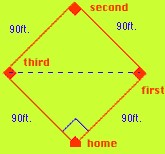With the World Series recently wrapping up, what better way to get students engaged in math than through real world application with our nation’s pastime, baseball. If I were teaching a unit on geometry, I would engage students and create discussion by simply bringing up the current relevance of baseball. Salvador Perez was just named the MVP of the World Series and was the catcher for the winning Kansas City Royals (Perez is one example, a teacher could exemplify any catcher, maybe even the catcher on your professional team if you have student supporters.) Catchers are always on alert when there’s a base runner on first as they might try to steal second. A teacher can use these pictures to show some of the dimensions and geometric make-up of the field, also good for any students unfamiliar with the sport. They could then go on and prompt the question, “While the runner fr om first only has to travel under 90 feet to reach second base with his lead off, how far does the catcher have to throw the ball to get the runner out at second?” Students could use the Pythagorean Theorem as is the state standard, or some may even be creative to see the isosceles triangle within the baseball infield’s dimensions and use one of the side lengths to determine the answer. Applying this back to the real world it can show how much of an advantage a runner may have or just how great a catcher has to be to consistently get runners out, such as Salvador Perez.
om first only has to travel under 90 feet to reach second base with his lead off, how far does the catcher have to throw the ball to get the runner out at second?” Students could use the Pythagorean Theorem as is the state standard, or some may even be creative to see the isosceles triangle within the baseball infield’s dimensions and use one of the side lengths to determine the answer. Applying this back to the real world it can show how much of an advantage a runner may have or just how great a catcher has to be to consistently get runners out, such as Salvador Perez.
If student’s seemed inter ested and they truly were engaged by the mathematical dynamics that makes up the game of baseball, teachers could build upon the dimensions of the field to prompt students towards higher level mathematics applications, for example using a runner’s actual speed and distance needed to travel to figure out how fast the baseball would have to be thrown to successfully throw the runner out (with a direct throw.) Teachers might also use the triangles found in the infield and speak upon congruency theorems!
ested and they truly were engaged by the mathematical dynamics that makes up the game of baseball, teachers could build upon the dimensions of the field to prompt students towards higher level mathematics applications, for example using a runner’s actual speed and distance needed to travel to figure out how fast the baseball would have to be thrown to successfully throw the runner out (with a direct throw.) Teachers might also use the triangles found in the infield and speak upon congruency theorems!